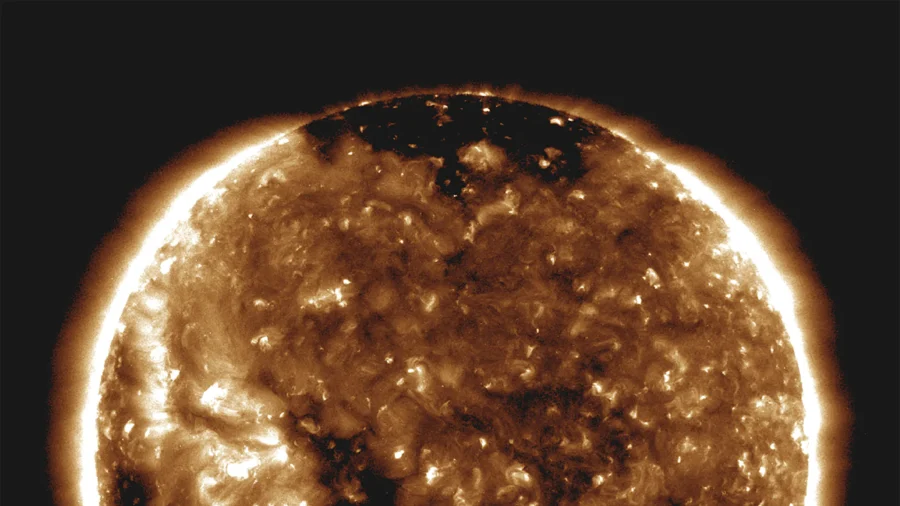A giant “hole” more than five times bigger than the planet Jupiter opened up in the sun’s atmosphere and temporarily unleashed powerful solar winds toward Earth this week.
Also known as a “coronal hole,” the massive opening in the sun’s magnetic field began appearing near the sun’s equator on Dec. 2 and quickly reached its maximum width of nearly 497,000 miles (800,000 kilometers) within just days, Spaceweather.com reported.
The giant hole was also captured on camera by NASA’s Solar Dynamics Observatory.
Coronal holes typically appear as dark areas in the solar corona in extreme ultraviolet and soft X-ray solar images, according to the National Oceanic and Atmospheric Administration (NOAA). They are a common part of the sun’s normal activity and are generally not cause for concern.
Coronal holes can occur at any time and location on the sun, and happen when its magnetic field opens up, allowing high-speed solar wind to rapidly escape into space, which can, in turn, create geomagnetic storms.
Depending on the side of the geomagnetic storms, they can sometimes cause a major disturbance of Earth’s magnetosphere, the effects of which can linger for weeks and result in moderate-to-strong auroras that can be viewed on the ground, provided the skies are clear.
They can also interfere with communication satellites and long-distance cables relied upon for internet usage and trigger radio blackouts and power outages.
Owing to their potential to increase geomagnetic activity and possible storming, forecasters analyze coronal holes regularly.
The giant void initially discovered on Dec. 2 had been pointed directly toward Earth since Dec. 4, and experts warned it would likely result in a moderate (G2) geomagnetic storm hitting Earth between Dec. 4 and 5.
Geomagnetic Storms
The NOAA Geomagnetic Storm Scale indicates that a G2-class geomagnetic storm could trigger voltage alarms on high-latitude power systems, while lengthy storms could cause transformer damage.
However, the solar wind has been less intense than expected, resulting instead in a G1 storm, Space.com reported.
Despite the less intense geomagnetic storm, there still remains a small possibility of seeing auroral displays, especially at higher latitudes.
Prior to the discovery of the latest coronal hole, another one was observed by experts on the sun in March.
That one resulted in the most powerful geomagnetic storm to slam into Earth in more than six years, producing auroras that were visible from as far south as New Mexico in the United States, and causing spaceflight company Rocket Lab to delay a planned launch by 90 minutes.
While the latest coronal hole does not pose a concern, it is unusual to be seen given increased solar activity.
According to NOAA, while coronal holes can occur at any point throughout the solar cycle, they tend to be more common during a solar minimum.
It is unclear how long the latest coronal hole will remain in the sun, although they can last for up to 27 days, according to NOAA.
Its discovery comes as solar activity is ramping up as the sun nears the explosive peak in its roughly 11-year solar cycle, known as the solar maximum, which is expected to peak in early 2024.
Scientists revised that estimation in October after previously believing the peak would begin in 2025.
From The Epoch Times

